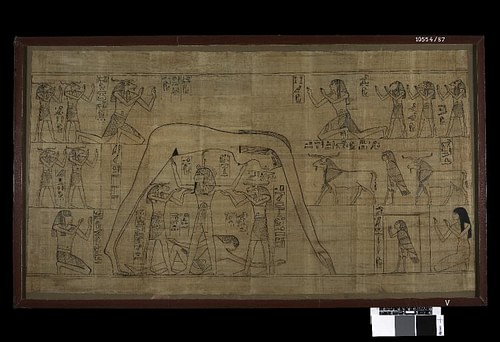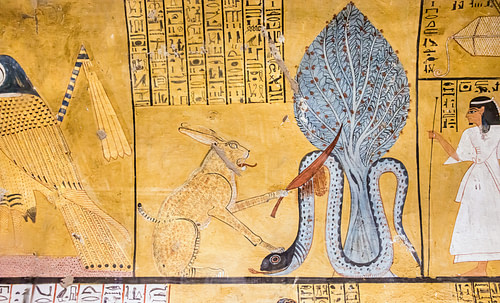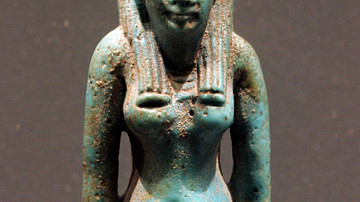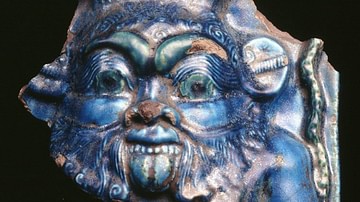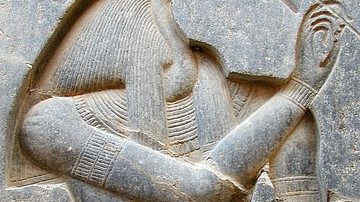The land of ancient Egypt was alive with the spirit of the gods. The sun god Ra broke from the darkness every morning in his great boat, bringing the light, and many of the gods watched over the people by night as the stars. Osiris caused the Nile River to flood its banks and fertilize the land while Khnum directed its flow. Isis and her sister Nephthys walked with the people of the land in life and protected them after death, as did many of the other gods, and Bastet guarded the lives of women and watched over the home. Tenenet was the goddess of beer and brewing and also present at childbirth, while Hathor, who had many roles, was one's close companion at any party or festival as the Lady of Drunkenness.
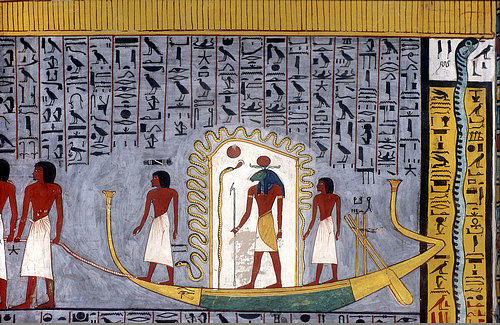
The gods and goddesses were not distant deities to be feared but close friends who lived among the people in the temple-homes built for them, in the trees, lakes, streams, swamps, and out in the desert beyond the Nile River Valley. When the hot winds blew in from the arid wastes it was not just a confluence of air but the god Set stirring up some trouble. When the rain fell it was a gift of the goddess Tefnut, "She of Moisture", who also was associated with dryness and was asked to hold back the rain on festival days. Human beings were born from the tears of Atum (also known as Ra) when he wept for joy at the return of his children Shu and Tefnut in the beginning of time when the world was created from the waters of chaos. In all aspects of life, the deities of Egypt were present and continued to care for their people after death.
Origins of the Deities
Belief in supernatural entities is attested to as early as the Predynastic Period in Egypt (c. 6000-3150 BCE) but the practice is no doubt much older. As historian Margaret Bunson writes:
The Egyptians lived with forces that they did not understand. Storms, earthquakes, floods, and dry periods all seemed inexplicable, yet the people realized acutely that natural forces had an impact on human affairs. The spirits of nature were thus deemed powerful in view of the damage they could inflict on humans (98).
The early belief in the gods took the forms of animism, the belief that inanimate objects, plants, animals, the earth have souls and are imbued with the divine spark; fetishism, the belief that an object had consciousness and supernatural powers; and totemism, the belief that individuals or clans have a spiritual relationship with a certain plant, animal, or symbol. In the Predynastic Period animism was the primary understanding of the universe, as it was with early people in any culture. Bunson writes, "Through animism humankind sought to explain natural forces and the place of human beings in the pattern of life on earth" (98). Animism not only concerned higher cosmic forces and earth energy but the souls of those who had died. Bunson explains:
The Egyptians believed firmly that death was just a doorway to another form of existence, so they acknowledged the possibility that those who had died were more powerful in their resurrected state. Thus politically, spiritually, or magically powerful members of each community took on special significance in death or in the realm beyond the grave. Special care was taken to provide such souls with all due honors, offerings, and reverence. Dead persons were thought to be able to involve themselves in the affairs of the living, for good or ill, and thus had to be placated with daily sacrifices (98).
The belief in a life after death gave rise to an understanding of supernatural beings who presided over this other realm which connected them to the earthly plane seamlessly. The early evolution of religious belief can perhaps best be summed up by the line from Emily Dickinson's poem number 96 (best known as My Life Closed Twice Before its Close): "Parting is all we know of heaven" or from Larkin's Aubade where religion is "created to pretend we never die." The experience of death required some explanation and meaning which was provided by a belief in higher powers.
Animism branched off into fetishism and totemism. Fetishism is exemplified in the symbol of the djed, representing earthly and cosmic stability. The djed symbol is thought to have originally been a fertility sign, which came to be associated with Osiris so closely that inscriptions such as "the Djed is laid on its side" meant Osiris had died while the raising of the djed symbolized his resurrection. Totemism evolved out of local association with a certain plant or animal. Every nome (province) of ancient Egypt had its own totem, whether a plant, animal, or symbol, which signified the people's spiritual connection to that locale. Every Egyptian army marched into battle divided into nomes, and each nome carried its own staff flying its totem. Individuals each had their own totem, their own spirit guide who watched over them especially. The king of Egypt, in any period, was watched over by a hawk who represented the god Horus.
In time, these spirits understood through animism became anthropomorphized (attributing human characteristics to non-human things). The invisible spirits which inhabited the universe were given form, shape, and names and these became the deities of ancient Egypt.
Mythological Origins
The primary creation myth of the Egyptians begins with the stillness of the primordial waters before the beginning of time. Out of these endless, depthless waters rose the primordial mound (the ben-ben). The pyramids of Egypt have been interpreted as representing this first hill of earth to rise from the primordial depths. Existing eternally with these silent waters (Nu) was heka - magic - personified in the god Heka who in some versions of the myth causes the ben-ben to rise.
Upon the mound stood the god Atum (or Ra) or, in some versions, he alights upon it from the air. Atum looked upon the nothingness and recognized his aloneness and so, through the agency of heka, he mated with his own shadow to give birth to two children, Shu (god of air, whom Atum spat out) and Tefnut (goddess of moisture, whom Atum vomited out). Shu gave to the early world the principles of life while Tefnut contributed the principles of order.
Leaving their father on the ben-ben, they set out to establish the world. In time, Atum became concerned because his children were gone so long and so removed his eye and sent it in search of them. While his eye was gone, Atum sat alone on the hill in the midst of chaos and contemplated eternity. Shu and Tefnut returned with the eye of Atum (depicted as the famous All-Seeing Eye), and their father, grateful for their safe return, shed tears of joy.
These tears, dropping onto the dark, fertile earth of the ben-ben, gave birth to men and women. These creatures had nowhere to live and so Shu and Tefnut mated to give birth to Geb (earth) and Nut (sky) who fell in love so deeply that they were inseparable. Atum was displeased and pushed them away from each other raising Nut high above Geb and fastening her to the canopy of the cosmos. She was already pregnant by Geb, however, and gave birth to the first five gods: Osiris, Isis, Set, Nephthys, and Horus. From these original gods then came all the others.
An alternate version of creation is very similar but includes the goddess Neith, one of the oldest of all Egyptian deities. In this version, Neith is the wife of Nu, the primordial chaos, who gives birth to Atum and all the other gods. Even in this myth, however, Heka pre-dates Neith and the other gods. In a number of inscriptions throughout Egypt's history Neith is referred to as the "Mother of the Gods" or "Mother of All" and is among the earliest examples of the Mother Goddess figure in history. In yet another version, the Nu (chaos) is personified as Nun, the father and mother of all creation who gives birth to the gods and everything else in the universe.
According to the egyptologist Geraldine Pinch, once the gods were born and creation set in motion,
Qualities of the primeval state, such as its darkness, were retrospectively endowed with consciousness and became a group of deities known as the Eight or the Ogdoad of Hermopolis. The Eight were imagined as amphibians and reptiles, fertile creatures of the dark primeval slime. They were the forces that shaped the creator or even the first manifestations of the creator (58).
The symbol of the ouroborus, the snake swallowing its own tail, representing eternity, comes from this connection of the serpent with creation and the divine. Atum (Ra) is depicted in early inscriptions as a serpent, and later he is the serpent-as-sun-god (or a sun deity protected by a serpent) who battles the forces of chaos symbolized by the serpent Apophis.
The Nature of the Gods & Goddesses
The deities of ancient Egypt maintained harmony and balance after the primordial One divided at creation. Geraldine Pinch writes, "Texts that allude to the unknowable era before creation define it as the time 'before two things had developed'. The cosmos was not yet divided into pairs of opposites such as earth and sky, light and darkness, male and female, or life and death" (58). In the beginning, all was One and then, with the rise of the ben-ben and the birth of the gods, multiplicity entered creation; the One became the many.
Egyptian religious beliefs centered on the balancing of these 'many' through the principle of harmony known as ma'at. Ma'at was the central value of Egyptian culture influencing every aspect of the people's lives from how they conducted themselves to their art, architecture, literature, and even their vision of the afterlife. The power which enabled the gods to perform their duties, allowed human beings access to their gods, and sustained ma'at was heka. Heka, the god, is represented in the Coffin Texts as claiming to have existed before any other deity.
Like the people of Mesopotamia, from whom some scholars claim the Egyptians developed their religious beliefs, the people of Egypt believed they were partners with the gods in maintaining order and holding the forces of chaos at bay. The story best illustrating this concept is The Overthrowing of Apophis which generated its own ritual. Apophis was the primordial serpent who, every night, attacked the sun barge of Ra as it traveled through the darkness toward the dawn. Different gods and goddesses manned the boat with Ra to protect him from Apophis, and the souls of the dead were also expected to help fend off the serpent. One of the most famous images from this story shows the god Set, before he became known as the villain of the Osiris Myth, spearing the serpent and protecting the light.
The ritual which grew out of the story included people making images of Apophis from wood or wax and then destroying them with fire to help the souls of the dead and the deities who traveled with them to bring the morning sun. Cloudy days were troublesome to the ancient Egyptians because they were taken as a sign that Apophis was overpowering Ra; a solar eclipse was a source of great dread. The Egyptians, through rituals and devotion to their gods, helped the sun to rise again every morning and each day was seen as a struggle between the forces of order and chaos. Geraldine Pinch writes:
When creator gods such as Atum are spoken of as serpents they usually represent the positive aspect of chaos as an energy force but they had a negative counterpart in the great serpent Apophis. Apophis represented the destructive aspect of chaos that constantly tried to overwhelm all individual beings and reduce everything back to its primeval state of "oneness". So, even before creation began, the world contained the elements of its own destruction (58).
This destruction would overwhelm even the gods and goddesses themselves. The return to the state of wholeness, of the many combining back into the One, was considered inevitable. Scholar R. H. Wilkinson notes how "a number of Egyptian texts show that although the gods were not considered to be mortal in the usual sense, they could nevertheless die" (20). This belief seems to have come from the Egyptian value of balance and harmony; as the multiplicity of the universe had arisen from the One, it would someday return to its original state. A god like Osiris could be killed and then return to life but this was only a temporary situation; one day, all would be gathered back into the primordial chaos from which it had come. Wilkinson writes:
The principle of divine demise applies, in fact, to all Egyptian deities. Texts which date back to at least the New Kingdom tell of the god Thoth assigning fixed life spans to humans and gods alike, and Spell 154 of the Book of the Dead unequivocally states that death (literally, 'decay' and 'disappearance') awaits 'every god and goddess'...and only the elements from which the primordial world had arisen would eventually remain (21).
The concept of oneness, of recognition of an undifferentiated whole, was not valued by Egyptian culture as it was by certain aspects of Chinese or Hindu culture but was rather feared. To return to undifferentiated oneness meant the loss of one's personal identity, one's memory, one's accomplishments in life, and loved ones; this thought was intolerable to the ancient Egyptians. In the afterlife, instead of a 'hell', the worst thing which could happen to a soul was to be judged unfit for paradise. When the heart of the soul was weighed against the white feather of truth and was found to be heavier it was dropped onto the floor and eaten by the monster Ammut.
The heart was believed to be the center of one's personality and spirit, and once it was eaten, the soul ceased to exist. Non-existence was terrifying to the Egyptians. Bunson writes, "The Egyptians feared eternal darkness and unconsciousness in the afterlife because both conditions belied the orderly transmission of light and movement evident in the universe" (86). That "transmission of light and movement" was life itself. The elaborate vision of the Egyptian afterlife as a perfect reflection of one's life on earth developed precisely because of this fear of non-existence, of losing one's self. When the gods finally died, after millions of years, human beings would die with them and all of human history would be rendered meaningless.
The Death of the Gods & Goddesses of Egypt
The gods and goddesses of ancient Egypt did eventually die and it did not even take millions of years. The rise of Christianity meant the end of ancient Egyptian religious practices and a world imbued and sustained by magic. God now resided in heaven, a single deity far from the earth, and there were no longer the multiplicity of gods and spirits inhabiting one's daily life. Even though this new god could be present through the intermediary of his son Jesus Christ, he is still described by the Christian scriptures themselves as "dwelling in light inaccessible" (I Timothy 6:16). The image of the divine serpent had already been taken by the Jewish scribes and transformed into a symbol of human beings' fall from paradise (Genesis 3) and the earth itself, far from being inbued with the spirits of friendly gods was now considered evil by the Christian scriptures and under the control of their adversary Satan (Romans 5:2, II Corinthians 4:4, Galatians 1:4, I John 5:19, etc). By the 5th century CE the Egyptian gods were dwindling, and by the 7th century CE they were gone. As Wilkinson notes, however, they did not go quietly:
In AD 383 pagan temples throughout the Roman Empire were closed by order of the Emperor Theodosius and a number of further decrees, culminating in those of Theodosius in AD 391 and Valentinian III in AD 435, sanctioned the actual destruction of pagan religious structures. Soon most of Egypt's temples were shunned, claimed for other use, or actively destroyed by zealous Christians, and the ancient gods were largely deserted (22).
Wilkinson and others note how the ancient Egyptian beliefs lived on in spite of Christianity's and then Islam's attempts to destroy them. The Myth of Osiris, with its central Dying and Reviving God figure, became central to the Cult of Isis which traveled to Greece after Alexander the Great conquered Egypt in 331 BCE. From Greece, worship of Isis was taken to Rome where her cult became the most popular religious belief in the Roman Empire before the rise of Christianity and its most stubborn opponent afterwards. Temples to Isis have been found all over the ancient world from Pompeii through Asia Minor, throughout Europe, and into Britain.
The concept of the Dying and Reviving God which had long been established through the Osiris Myth was now made manifest in the figure of the son of God, Jesus the Christ. In time, epithets for Isis became those for the Virgin Mary such as "Mother of God" and "Queen of Heaven" as the new religion drew on the power of the older belief to establish itself. The Abydos Triad of Osiris, Isis, and Horus became the Trinity of Father, Son, and Holy Ghost in the new religion which had to destroy the old belief in order to achieve supremacy.
The Temple of Isis on Philae in Egypt is considered the last pagan temple to have survived. Records show that in 452 CE pilgrims visited the Temple of Philae and removed the statue of Isis, carrying her in honor as in former days to visit with the neighboring gods of Nubia (Wilkinson, 23). By the time of the emperor Justinian in 529 CE, however, all pagan beliefs were suppressed. There were no doubt pockets of resistance to the new faith but the widespread veneration of the old gods was now a memory. Wilkinson writes:
By AD 639 when Arab armies claimed Egypt they found only Christians and the disappearing legacy of ancient gods who had ruled one of the greatest centres of civilization for well over 3,000 years (23).
The gods and goddesses of Egypt would never completely vanish, however. They infused the new monotheistic ideologies of Judaism, Christianity, and Islam. Of the Five Pillars of Islam, prayer, pilgrimage, fasting, and alms-giving were all practiced millennium before by the ancient Egyptians in the worship of their gods. The concept of heka, an eternal, invisible force which empowered creation and sustained life, was developed by the Greek and Roman Stoics and the Neo-Platonists as the Logos and the Nous, respectively, and both of these philosophies influenced the development of Christianity.
In the modern day, people routinely refer to the faith of the ancient Egyptians as a primitive, polytheistic faith; however, the Egyptian gods were worshipped for more than 3,000 years and the only religiously-themed conflict recorded was during the reign of Akhenaten (1353-1336 BCE) when the king insisted on a monotheistic reverence for the supreme god Aten and even this was most likely more of a political maneuver to decrease the power of the Priests of Amun. For the greater part of Egypt's history, making war on the grounds of religion would have gone against one of the most important values the gods gave to the people: harmony.
